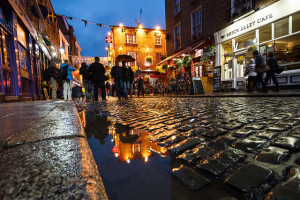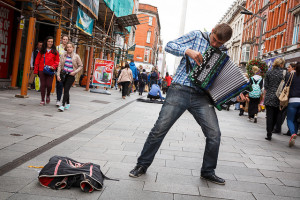Since some friends of mine are headed to Dublin, Ireland, soon, this seemed like a good time to extol the virtues of one of my favorite cities.
If course, it helps if you like Guinness stout — but there’s more to Dublin than Ireland’s national drink (no offense to Irish whiskey).
Still, any top seven list of things to do in Dublin has to start with sampling some Guinness. You can get a well-poured pint in any pub in the city, but you can get a great orientation to both Guinness and Dublin’s literary heritage by joining the:
* Dublin Literary Pub Crawl. This is a fun 2 1/2-hour evening event that combines literary storytelling by two talented actors with the chance to sip a Guinness (or other drink) at four different pubs. It starts at the Duke Pub (9 Duke St., Dublin) and then continues to others (such as O’Neill’s and the Old Stand) as the actors recite quotations and tell tales about great Dublin writers such as James Joyce, Brendan Behan, W.B. Yeats, Samuel Beckett, Sean O’Casey, and Oscar Wilde. One of my favorite quotes was from playwright Brendan Behan, who was known to have frequented almost all 750 pubs in Dublin: “I’m a drinker with a writing problem.” And here’s another Behan quote, this when he visited Canada and saw a sign that read “Drink Canada Dry”: “So here I am.” Pay attention, because there’s a quiz at the end — you may win a T-shirt.
* You can learn more about Dublin’s famous writers at the Dublin Writers Museum on Parnell Square (once the home of George Jameson of Irish whiskey fame). The restored 18th-century house has manuscripts, exhibits and provides an overview on Joyce, Behan, Wilde, O’Casey, Beckett, Yeats, George Bernard Shaw, Oliver Goldsmith, and other eminent Irish dramatists, poets, short story writers and novelists. If it’s more stout you’re after, other well-known Dublin pubs with literary connections include McDaid’s and Davy Byrne’s. The two really do go together. As my son Grael once wrote, “Dublin prompts easy associations — good Guinness, good writers, and good conversations over Guinness about writing.”
Of course, at some point following the Pub Crawl you’ll want to visit:
* The Guinness Storehouse. This is the number one attraction in Ireland that charges a fee, and while it’s still a working building you can take a self-guided tour to learn the history and background of the national drink, which Arthur Guinness developed in 1759. On the tour, you follow a pint of Guinness along through the entire brewing process, from barley to hops to yeast and fermentation, essentially a modernized version of the same process used in the 18th century. The Storehouse, built in 1904, was Europe’s first “skyscraper” — it’s shaped like a pint of Guinness — and at the end of the tour you can sample a pint at the seventh-floor Gravity Bar, which serves as the “head” of the pint. From the bar you can get a panoramic view of the city through picture windows.
Now that your thirst is sated, it’s time for some culture:
* Trinity College and the Book of Kells. Stroll through the beautiful 18th-century brick courtyard of the college to the Old Library for a look at the famous Book of Kells, a fabulously illuminated manuscript of the biblical gospels produced by monks around 800 AD. You can only view a few pages under glass, often surrounded by crowds of visitors, but it’s worth the trip. While there, check out other Irish literary treasures in the country’s largest collection of printed books and manuscripts. The film Educating Rita, starring Michael Caine and Julie Walters, was filmed mostly at Trinity College, which was founded in 1592 and now attracts students from around the world.
And distinctive parks and architecture:
* St. Stephen’s Green. St. Stephen’s Green is Dublin’s nicest and most popular park, with cultivated 19th-century gardens, a lake, and woodsy areas to roam. Dublin’s landmark hotel, the Shelbourne, faces the green, which is lined by Georgian-era brick buildings, one of which was once occupied by Sir Benjamin Guinness, Arthur’s grandson. James Joyce went to school right down the block, and sculptures of Joyce and W.B. Yeats both adorn the park.
* Merrion Square. This square, which also features a well-manicured public park, is the heart of Georgian Dublin, with the city’s most distinctive architecture found in its late 18th-century townhouses. (The 18th century represented a huge flowering of social and commercial activity in Dublin, when it went from a city of 65,000-person backwater to the sixth-greatest city in Europe, with 250,000 population.) The first Georgian-era mansion, which stands across from the square, dates from 1745, but most of the townhouses were built from 1764 to 1790 during the reign of King George. Pay particular attention to their painted doors, topped by carvings and iron balconies. The townhouses are now occupied mostly by businesses. The National Gallery of Ireland, the country’s top art museum, is located on the square, and the park contains a sculpture of Oscar Wilde, who grew up at #1 Merrion Square.
After taking all this in, you’ll want a cup of tea at
* Bewley’s Cafe, Dublin’s best-known teahouse (currently closed for renovations, reopening later this year), located on busy Grafton Street, known as a shopping mecca. You’ll need to restore yourself for an evening of prowling the Temple Bar area (bar means “walkway”), which is a trendy area near the River Liffey featuring lots of pubs, restaurants, galleries, bookstores, and boutiques — it’s the oldest intact part of Dublin, once the main commercial area of the city. There are many old buildings here, and others made to look old — a good place to cap a visit to Ireland’s greatest city.














One Response to Seven Things Not to Miss in Dublin